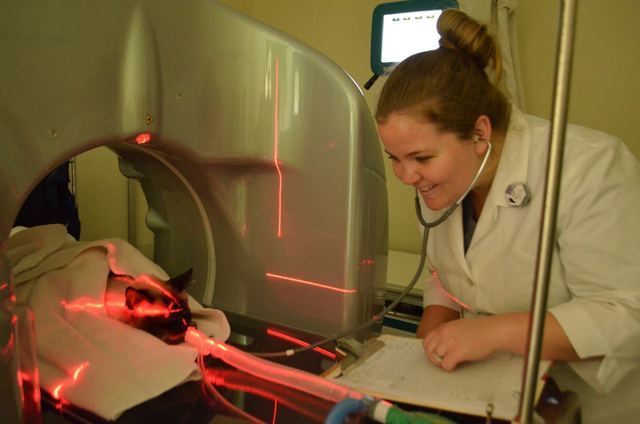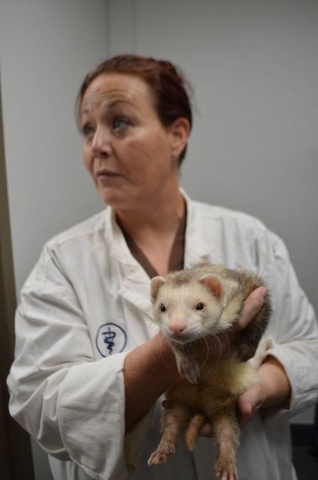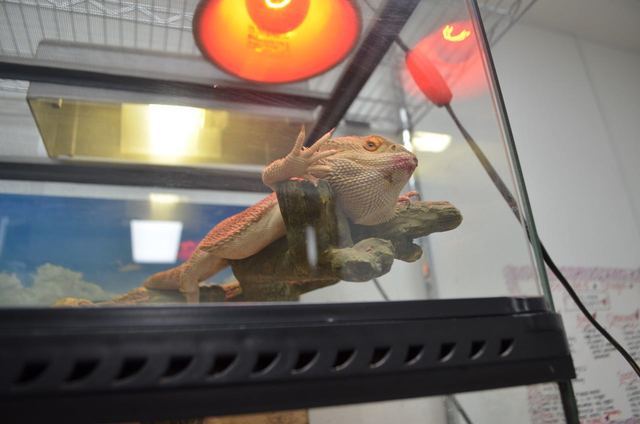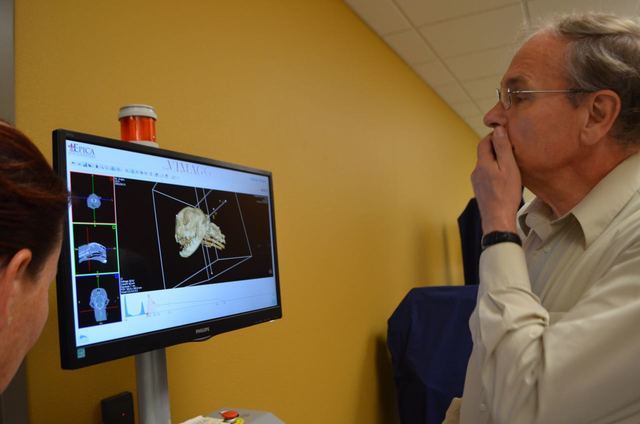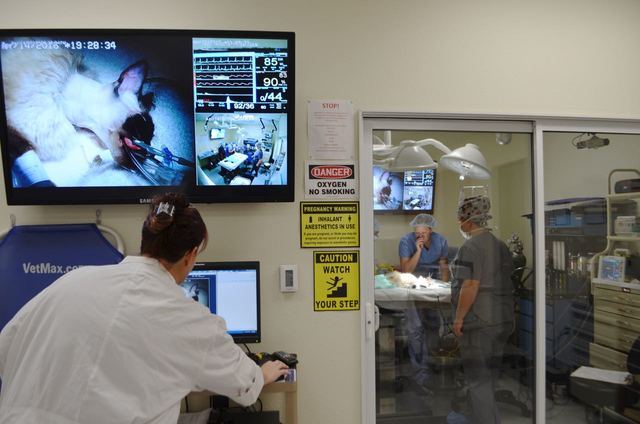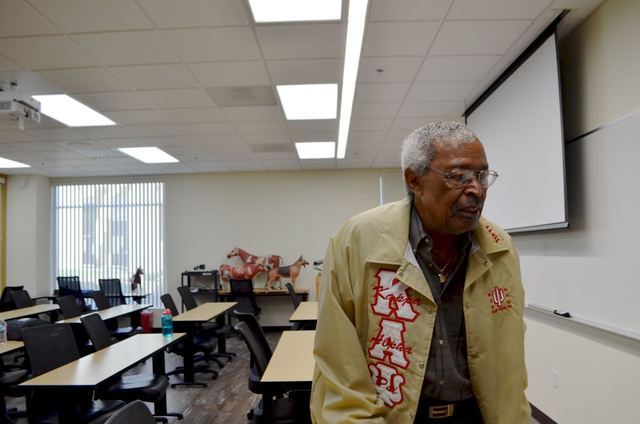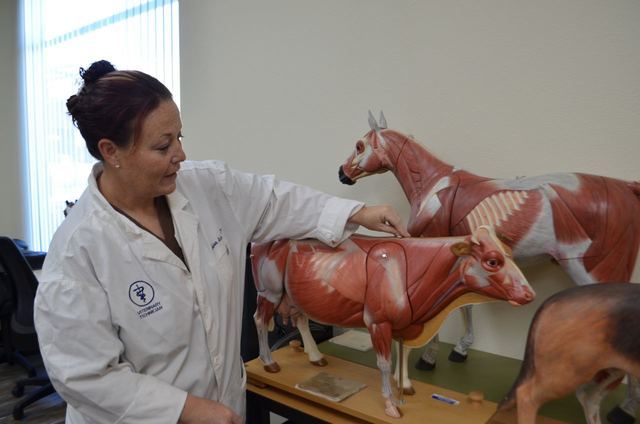College of Southern Nevada students explore veterinary technology with CT scanner
It’s not every day you see a cat get a CAT scan.
The College of Southern Nevada’s veterinary technology program used funding from a Federal Perkins Grant to purchase a state-of-the art Vimago veterinary CT scan machine. CSN faculty and students recently used the robotic, high-definition, computed tomography system, one of only two Vimago systems in Nevada, to examine a tumor in the ear of a longhair Himalayan feline.
“We try to show these students everything,” CSN senior specialist and instructor Melissa Schalles said. “We try to give them the hands-on experience in everything they are going to do.”
The Himalayan was referred to the veterinary clinic at CSN when a private practice veterinarian discovered a bump in his ear he knew had to be a tumor.
All of the CSN clinic’s patients are pets of faculty or staff, or they come in as referrals from outside private clinics. There is no direct public access to the clinic.
“I’m a pretty good gatekeeper,” Schalles said.
She said some pet owners try to approach the clinic thinking the services will be less expensive than private care.
“We are not cheap,” Schalles said. “We’ll get owners who call and say, ‘I hear you’re cheap.’ I have a board-certified veterinary surgeon here. We have two licensed veterinary nurses here who have more experience combined together than most of your veterinary practices. Believe me, we are not cheap.”
The focus at the clinic is on student experience.
Schalles, veterinary nurse and professor Aubree Englert and the program’s director, Dr. Dennis Olsen, allow students to do as much as possible.
“What we allow our students to do is pretty much everything,” Schalles said. “Our students induced the animal and intubated the animal. We confirm everything.”
Students also assisted in positioning the cat for the scan using positioning lasers. Once everything was confirmed, the machine was activated. It spun around slowly, taking more than 700 images to be reconfigured into a three-dimensional model of the cat’s head.
“Once the CT is done here, we can do surgery here at this facility, we can refer them back to their veterinarian, or I can send this via the Internet to a board-certified radiologist, and the radiologist, who is certified to read CT scans, can read it and give me a radiologist’s report just like you would receive when you go to their doctor,” Schalles said.
In the Himalayan’s case, a radiologist’s report wasn’t necessary. Olsen could see the problem right away.
“There’s the opening into the ear canal, and if I back it up just a little bit, we can start seeing the soft tissues inside that ear canal,” Olsen said as he explained the images to students and the cat’s owners. “So now you can actually see the tumor that’s in there. It’s pretty impressive. We can take the skin off. We can make it so it’s just bone. And to be able to rotate it around so you can see a front view, minus his nose.”
Olsen said the image was good enough that he could see the individual bones that suspend the cat’s voice box.
“Hopefully that tumor we can see in the ear canal will just be able to slide right out,” Olsen added.
Unlike a traditional clinical setting, at CSN’s clinic, the cat’s owners were invited to stick around and watch the surgery.
“Most places, they have the back, and that’s where they go,” Englert said as she helped students prepare the cat for surgery. “That’s where most of your treatments and even simple things like vaccines most of the time happen in the back. We don’t have a back. If they want to, we will let them stay though an entire surgery. It’s up to the owners. Some of them want to stay and watch. Some of them prefer not to. But we don’t ever tell people they can’t be here.”
Surgery spectators don’t have to be in the room to see it.
“Inside our surgical suite, we have four cameras,” Schalles explained. “I have two cameras that rotate up on the ceiling and then two stationary cameras, and I can record the entire surgery.”
In addition to the surgical suite and radiology department, the clinic is stocked with traditional X-ray equipment and a multitude of blood and fluid testing equipment to give students experience on as many equipment styles and brands as possible.
Treatment is only part of the educational process in the program. While the university does not own any animals, students and teachers bring in their pets to give participants a chance to practice handling and caring for a variety of species, from Schalles’ ferrets Bella and Edward to bearded lizards, snakes, rats, mice, dogs, cats and more.
The animals are kept in holding rooms separated by species with independent air filtration for each room.
“Every fall, we practice an emergency evacuation drill where each student is responsible for his own animal,” Schalles said.
In addition to the clinic, students have access to books, labs, equipment to practice drawing blood or inserting IVs, preserved dissected animals and animal models that can be taken apart to learn animal anatomy. Schalles said each student is issued a key card and a personal pin code so they can access the labs and classrooms 24 hours a day.
Students also get experience outside the school working with veterinarians at the Shark Reef and Siegfried & Roy’s Secret Garden & Dolphin Habitat and working with Olsen on large animals in his veterinary practice.
“These students come out seeing these types of procedures that they may not see otherwise,” Schalles said. “We do open-heart surgeries here, a lot of orthopedics, and we do routine procedures.”
In addition to instructors who run the clinic, students have access to a variety of full-time and part-time instructors with years of experience in the field, professionals such as Dr. Jerome Goldsboro, who instructs students in laboratory animal medicine using knowledge gained caring for NASA’s primate astronauts.
Visit sites.csn.edu/health/vet-tech.html.
Contact View contributing reporter Ginger Meurer at gmeurer@viewnews.com. Find her on Twitter: @gingermmm.



